Johnson didn't make his lot any easier by his
policy with women. After being disappointed in love by two successive Black
women he foreswore colored girls for White women. Maybe he knew something
about White women that us White guys don't. At the time of the championship
he was married to Etta Duryea. Johnson said that she was of French ancestry,
although Duryea is an Irish name and the woman looks more Irish than French.
Perhaps he identified her as French to defuse Irish anger.
If she was Irish then the Irish certainly felt that they
had double the incentive for their rage.
Returning to Chicago, where he had taken up residence,
with his prize money of seventy thousand or so which represents millions
in today's money, Johnson perhaps unwisely adopted a high profile life
style. He opened a nightclub called the Cabaret de Champion which was a
great success.
Remember that we aren't discussing morality or right and
wrong here but only what happened. It is quite possible that the Irish
took the name of his nightclub, Cabaret de Champion, as a fresh offence
to the beating of their Pride. They may very well have thought the French
name was a "nigger putting on airs."
Johnson also made the mistake of encouraging a cosmopolitan
crowd, mingling the Black and White races in his clientele. This may have
made him look like a "revolutionary" trying to break down race distinctions.
During this period Johnson was exposed to the most vituperative
newspaper reporting. Any minor faux pas received headline coverage
in the papers. No attempt at ridicule was missed. In the background try
to imagine what effect this defamation had on the Negroes of Chicago's
Black Belt. Johnson must have endured outrageous insults every day of his
life as Chicagoans tried to provoke him into any act for which criminal
charges could be filed.
One can only conjecture that Johnson's wife, Etta Duryea,
was driven to commit suicide, which she did some eleven months after the
Cabaret was opened. With her death Johnson closed the Cabaret de Champion
down, either wisely or under threat. Perhaps he got the hint; shooting
yourself in the head is not the preferred method of suicide by women.
Unable to defeat Johnson in the ring, while being unable
to provoke him into unwise deeds, those now unsmiling Irish eyes just lodged
false charges against him. After all they had City Hall and the judiciary
in the palm of their hands.
Johnson had taken a German girl, Belle Schreiber, with
him to a fight in San Francisco several years earlier. She was now induced
to bring charges against him for violation of the Mann Act. Interestingly
the Mann Act was introduced by the Irish Congressman James R. Mann of Chicago.
It was enacted on June 25, 1910, a few days before the big fight and quite
a while after Johnson had taken Belle Schreiber to San Francisco. The Mann
Act was designed to discourage the transportation of prostitutes across
State lines, not merely taking a girl friend on a lark. Any big man in
Chicago, including James Mann, could have been brought up on the latter
charge. I'm sure many, if not most, had taken their amours up to Wisconsin
or over to Michigan, or even perhaps to the Big Apple itself. Hypocrisy
to be sure, but when you control City Hall and the courts with no regard
for right or wrong in the legal sense only your will is law which creates
a different standard of right and wrong. That was the way the "laird" did
it on the Ould Sod.
Johnson was duly convicted to no one's surprise, but while
out of jail on appeal his mother told him she'd rather see his bacon in
exile rather than that he should spend a day in jail. On July 1, 1913,
Jack Johnson was driven from his native soil by Irish rage. This goes down
in history as an "American" or "White" injustice, not an Irish crime. I
didn't do it. I swear.
Just after Johnson's flight, Edgar Rice Burroughs sat
down to write
The Mucker. Whatever his original intent he worked
the current event into his story at the end. We will see him adapt his
story to current events spectacularly in "Out There Somewhere." From this
point it appears that Burroughs was watching the boxer's story unfold very
attentively.
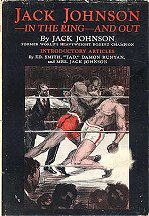 In
his autobiography Johnson never complains, while he was wise enough to
gloss over the true story. After all he had tens of thousands of
dollars still coming from that Moran fight. Whether Irish elements drove
him out of England and France is not clear but we do know that the IRA
and Sinn Fein had agents quite capable of doing it. The lonely Jack Johnson
was driven into Spain. Interestingly he learned the skill of the Matador
from reigning Spanish experts -- even doing duty in the bullring.
In
his autobiography Johnson never complains, while he was wise enough to
gloss over the true story. After all he had tens of thousands of
dollars still coming from that Moran fight. Whether Irish elements drove
him out of England and France is not clear but we do know that the IRA
and Sinn Fein had agents quite capable of doing it. The lonely Jack Johnson
was driven into Spain. Interestingly he learned the skill of the Matador
from reigning Spanish experts -- even doing duty in the bullring.
Even that must have been too much for his pursuers. We
next find him on Cape Finisterre reporting on German submarine activities
to the American army. Finisterre -- that translates into the end of the
earth -- so, symbolically and actually, unsmiling Irish eyes had driven
him to the end of the Earth.
Johnson wanted desperately to get back home. The Irish
desperately wanted the championship back. This is really colorful: Pancho
Villa arranged the fight between Johnson and Jess Willard for Ciudad Juarez
in Mexico just across the Rio Grande from El Paso. One assumes that the
fight would have netted him something more than mere chump change to carry
on his war with Venustiano Carranza, the Red President of Mexico. Carranza
let it known that if Johnson set foot in Mexico he would arrest him and
send him back to the United States.
The location of the fight was changed to Havana, Cuba,
where it was fought on April 5, 1915.
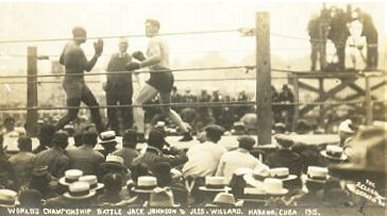 Johnson says that he was promised that if he threw the fight,
that is returned the title to the Irish, all would be forgiven and he could
return to Chicago. He wanted to see his mother before she died, but he
was allowed to return only after she had died. Coincidence or malice?
Johnson says that he was promised that if he threw the fight,
that is returned the title to the Irish, all would be forgiven and he could
return to Chicago. He wanted to see his mother before she died, but he
was allowed to return only after she had died. Coincidence or malice?
The Irish say there is no proof for such an allegation.
Quite right. Why would clever people leave a trail? With no further proof,
one must elect to believe Johnson of the Golden Smile or those unsmiling
Irish eyes. For myself, Johnson's story has the ring of truth, while I
know from experience what the word of people in power is worth when they
don't like you. Zip, nada, nothing. Suffice it to say that, unlike the
situation in Paris, Johnson insisted on having the money in his hand before
he got into the ring. As Johnson returned to Europe from Cuba, stripped
of his title, rather than returning directly to Chicago, one may assume
that he knew he had been betrayed.
As to the quality of Willard as a boxer it is generally
agreed that he was an amiable guy who everybody liked, but a very mediocre
boxer. While it is said that Johnson was out of condition, he nevertheless
managed to go twenty-six rounds in stifling heat under a blazing sun before
he
took his dive. Willard in no way punished him.
Jess Willard was an Anglo. Why an Anglo when the Irish
wanted the title back? I suspect that since they knew they hated Johnson
and were lying to him they thought he hated them equally and might lie
to them laying out an Irish boxer as a further insult to their collective
Ego. At any rate, this mediocre boxer, Jess Willard, was allowed to retain
the title while there was any chance of a return match with Jack Johnson.
On Independence Day 1919, nine years to the day when the Pride had hit
the canvas, Jack Dempsey reclaimed the title from its Anglo caretaker for
the Irish.
Johnson had a real longing to return to the States, as
Mark Sullivan unkindly puts it, "to be among his kind in the Black Belt
of the South Side Chicago where he belonged." Now, Sullivan was one of
the lace curtain Irish, as a guardian of national virtue he was the editor
of the Slick magazine, Colliers. If he, who was really a cultivated man,
took this attitude you can imagine what the attitude of the shanty Irish
might be.
Into 1917-18 Pancho Villa had been disposed of, leaving
Carranza more or less secure or perhaps as Johnson had no boxing match
providing Villa with millions, Carranza had no objection to Johnson residing
in Mexico. Johnson moved to Tijuana where, while waiting to work things
out with the authorities, he operated the Main Event Cafe. "Main Event."
I love this Freudian stuff.
Jack didn't bother to display his Matadorian skill in
the Corrida of Tijuana.
On the way across Mexico he had adventures so fantastic
that Burroughs would have been ridiculed for inventing them. His
train was stopped by a band of Pima Indians, who he believed had every
intent of murdering all the travelers. When he announced that he was Jack
Johnson the Indians crowded around him in admiration, restored the passengers'
valuables and sent them on their way unharmed.
Continuing to Mazatlan, the only boat he could hire was
one run by a smuggler with a load of fifty Chinese destined for the US.
At sea in true Burroughs fashion they were caught in a sudden squall driving
them into a cove for shelter. In a scenario for which Burroughs is criticized
for using, Johnson traveled inland for a few miles to come upon a band
of stone age Indians, living in what he described as indescribable squalor.
Continuing on, the captain brought the boat up the Colorado
to near the American border, where the Chinese turned right for Texas while
Johnson and his wife turned left for Tijuana.
There Johnson believed that he had worked out a deal with
the Irish of Chicago. For those followers of Americana ,Big Bill Thompson
was now mayor. The word came; Johnson began his trip to the Windy City
in the company of US Marshals. A crowd of believers waited expectantly
at the LaSalle Street Station, but here Johnson, as well as multitudes
of us, learned that White Men speak with forked tongue. Don't know what
the truth is; so crooked they don't know how crooked they are.
Just a few miles outside Chicago the train stopped at
Joliet State Prison. Rather than meeting an admiring crowd in Chicago Jack
Johnson's US Marshalls took him directly to jail.
Those unsmiling Irish eyes had Jack Johnson where they
wanted him. Black brows were furrowed in anger. After several months of
waiting he was sentenced to a year and a day in Leavenworth Federal Prison
-- the Mann Act was a federal crime. Jack Johnson was an innocent man and
all knew it but, shucks, that don't bother us none, do it?
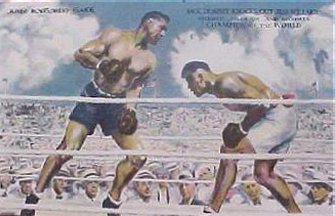 Independence
Day, July 4, 1919. Jack Johnson was out of the way, Jess Willard was no
longer needed, the Irish champ, Jack Dempsey, took center stage. The Pride
was back.
Independence
Day, July 4, 1919. Jack Johnson was out of the way, Jess Willard was no
longer needed, the Irish champ, Jack Dempsey, took center stage. The Pride
was back.
It is interesting to examine Dempsey's career in comparison
with Johnson's. Dempsey after all was the Irish revenge. The playing field
had been leveled a little, bulldozed down, by putting Johnson in prison
but he had it coming didn't he? The uppity nigger.
After John L. Sullivan, ring rules were modified to eliminate
bare knuckle boxing; after Johnson's championship the sport was modified
again -- one presumes, to level the field so Johnson wouldn't be able to
compete, discounting the fact that he was forbidden to compete. Beginning
with Dempsey was the legend of the miraculous punch. No matter how the
fight was going, if Dempsey unloaded the miraculous punch his opponent
hit the canvas. This "punch" was made possible by binding the hands combined
with a larger glove also protecting the hand which made it possible for
the boxer to ignore possible damage to his hand. the effect was transferred
to a boxer's brain.
Jack Johnson certainly fought as many rounds as any other
fighter; Sullivan, Corbett and Jeffries had all had long tough bouts, yet
none of them ended their days punch drunk as, say, Joe Louis or Cassius
Clay.
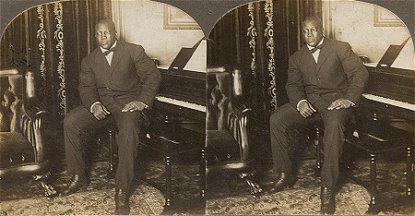
Stereoview of Jack Johnson in his Chicago home
As Johnson had been champion for just short of seven years
it was psychologically necessary for the Irish champion to best that. Thus
in just over seven years Dempsey turned the championship over to the Irish
Gene Tunney in Chicago. Psychologically the Irish believed they had avenged
the Negro insult to Burns, Jeffries and the Irish people so Tunney quickly
resigned the title undefeated as had Jeffries. No one called him back to
fight Joe Louis. The Irish then faded from the heavyweight boxing ranks.
The media was controlled by Whites so no notes of Negro
dissatisfaction were recorded. Had more attention been paid to Black opinion
a deep rumbling note of anger would have been heard. Note that the first
big race riots centered around the years 1919, 1920, 1921.
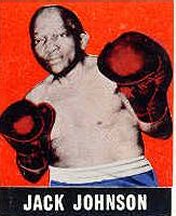
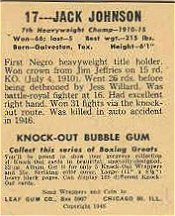
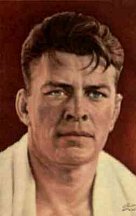
Jack Johnson 1948 Trading Card ~ Gene Tunney: Heavyweight
Champ 1926-28
To return to Edgar Rice Burroughs as he began to write
The
Mucker in August, 1913.
Billy Byrne, the Mucker, was Irish for a good reason.
As John the Bully had been Irish he had terrorized Burroughs not only into
a love-hate relationship with himself, but a love-hate relationship with
the Irish. For a long period Burroughs had subordinated his love of his
own people to that of the Irish.
The feeling was to haunt him all his life. In a period
of great psychological stress in 1931 when he was about to leave his wife
of thirty-one years, he wrote a story titled Pirate Blood. He wanted
it published under the pseudonym of John Tyler McCulloch. Avoiding a detailed
analysis of the choice of name let us note that John reflects his dual
attitude toward John the Bully while Tyler is a family name of his father.
The Irish McCulloch may actually be the real last name of John the Bully,
Burroughs' "born again" father. The provenance of the name McCulloch is
uncertain. I only speculate on its origin, nevertheless in a time of supreme
stress Burroughs reverted to an Irish identity he had assumed forty-seven
years earlier. The man had baggage to carry.
In the last pages of The Mucker Burroughs seems
to idolize the Irishers Corbett and Jeffries over the Big Smoke, as Johnson
was known in slang. Corbett the former champion was in Jeffries corner
in 1910.
When Johnson fled the country in 1913 this created a conflict
in Burroughs' mind. He too had fled running down the street, probably howling,
to the derision of the Irisher, John the Bully. Burroughs' heroes always
remark that they have been proud of their physical strength, now he saw
the heavyweight champion of the world running form the same Irish who had
terrorized him. While John the Bully had been bigger than him, the Irish
establishment of Chicago was bigger than Jack Johnson. The same Fate that
had been unjust and unkind to him now treated the toughest man in the world
the same way.
This happened just as Burroughs was entering his first
great psychological crisis which was to last for seven years or so. He
felt enormous sympathy for Johnson's plight as he lamented his own. His
mind was torn between his enthrallment to the Irish and his desire to resume
his own Anglo character. He was unable to reject his Irish connection in
favor of a Negro like Johnson, so in "Out There Somewhere" he combined
Byrne the Irish fighter with the Black Jack Johnson while reclaiming his
Anglo heritage in the character of Bridge.
The Mucker was his tenth novel while "Out There
Somewhere" was his twenty-third. Numerologists can make what they will
of the mystic numbers 10 and 23. I'm no believer in numerology, but I know
that historically 10 and 23, which is made up of 10, 12 and 1 or 13 have
great significance in the psychology of Homo Sapiens. I doubt if Burroughs
consciously planned these two important novels for those significant numbers,
but his subconscious was manipulating symbols in the Jungian sense.
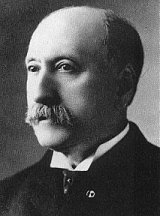 In
1910, before he began to write, interestingly he began his literary career
the year after Johnson beat the Irish hero. Burroughs was an absolute nobody
in Chicago, although he may have been remembered as his father's son. The
elder Burroughs had attained some prominence while his wife's father had
been a Chicago alderman.
In
1910, before he began to write, interestingly he began his literary career
the year after Johnson beat the Irish hero. Burroughs was an absolute nobody
in Chicago, although he may have been remembered as his father's son. The
elder Burroughs had attained some prominence while his wife's father had
been a Chicago alderman.
By 1913 he had attained some success in writing for the
pulp magazines. Nineteen thirteen was the first year that he made significant
money, actually changing his status from a pauper to a prince. His third
and fifth books of 1911 and 1912 had been Tarzan titles which created a
minor sensation, so he might have been attaining some recognition in Chicago,
but probably not much. By 1914, when Tarzan of the Apes appeared
in book form as a smash seller he began to come into his own. His only
book titles published in the 'teens were his first six Tarzan novels plus
A
Princess of Mars. The rest of his enormous magazine output of the 'teens
began to appear only in the twenties.
While never a social lion, as the 'teens passed and his
notoriety increased, certainly the big men of Chicago would want to "meet"
him. As on such occasions men's small talk runs to sports, and since Burroughs
was a boxing fan, it is most likely that inside tidbits about the
Affair Jack Johnson were confided to him.
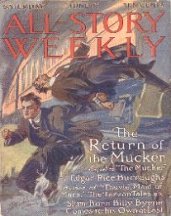 "Out
There Somewhere" was written from January to March in 1916. Jack Johnson
had given up the title on April 5, 1915. By 1916 negotiations for Johnson's
return had begun. Now remember when Burroughs pirates a political idea
he prefers "a definite impression of fictionalizing." "Out There Somewhere"
opens as Billy Byrne has abandoned his boxing hopes to return to Chicago
to prove his innocence. He gets the same short shrift that Johnson got
at his trial in 1912 and would get again a year or so later. Byrne is railroaded
through the courts from thence entrained to Joliet State Prison. Unwilling
to face a life sentence for a crime he didn't commit, Byrne escapes out
there somewhere into the hobo jungles where he is befriended by the Happy
Hobo, Bridge.
"Out
There Somewhere" was written from January to March in 1916. Jack Johnson
had given up the title on April 5, 1915. By 1916 negotiations for Johnson's
return had begun. Now remember when Burroughs pirates a political idea
he prefers "a definite impression of fictionalizing." "Out There Somewhere"
opens as Billy Byrne has abandoned his boxing hopes to return to Chicago
to prove his innocence. He gets the same short shrift that Johnson got
at his trial in 1912 and would get again a year or so later. Byrne is railroaded
through the courts from thence entrained to Joliet State Prison. Unwilling
to face a life sentence for a crime he didn't commit, Byrne escapes out
there somewhere into the hobo jungles where he is befriended by the Happy
Hobo, Bridge.
One knows that Burroughs has some familiarity with Knights
of the Road since he spent a year in a railroad shack's harness in Salt
Lake City in 1903-04. In addition he traveled through the jungles on the
railroad trip from Salt Lake City back to Chicago. What he did with the
rest of his spare time is hard to guess, but he seems to have first-hand
knowledge of the down and out, The Men Who Don't Fit In.
Further Burroughs, the dominant half of Burroughs split
persona, identifies with the down and out, with the dispossessed, thus
his alter-Animus, Bridge, is on the road, not on the yacht. On the Road
he is alone a fine decent man among a group of criminals. Burroughs makes
Bridge an astute judge of character although he himself confessed to possess
no such quality. He even confessed that his own illusions about his ability
to judge had proven false.
So when Bridge eyes Burroughs' other half of his Animus,
Billy Byrne, he notices the cuff marks on his wrists, but intuitively knows
the man is innocent. As innocent as Burroughs is himself. They team
up and as in Knibbs' poem Byrne rustles grub while Bridge rustles rhyme,
a division of labor in those years of labor unrest, at which Byrne takes
no offence.
Burroughs very deftly takes the duo from the hobo jungle
in Illinois across the country to El Paso, then across the river to Ciudad
Juarez where Villa had tried to organize the big fight between Johnson
and Willard.
One suspects that an earlier scene in the novel in which
two criminal hoboes try to rob the old lady is based on a crime that occurred
in the Midwest at this time. A sort of early day "In Cold Blood." Byrne
and Bridge thwart the attempt. I suspect that there was an actual murder
which Burroughs tries to reverse in his kindly way by a sort of magical
incantation.
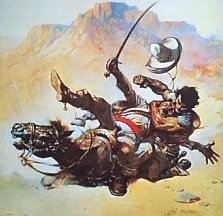 Fleeing
from the ubiquitous Chicago police who are hot on their trail they cross
over into Mexico at Juarez. At the time the Mexican Revolution was in full
swing. American Marines had taken Vera Cruz in 1915 when American business
interests were being expropriated as Carranza nationalized oil fields and
mines. It was at this time that Edward Doheny who would later be implicated
in the oil scandals of the Harding Administration lost his oil rights.
W.R. Hearst, the newspaper baron, lost his mining and ranching interests.
Burroughs and other Americans viewed these proceedings with horror. Thus
Barbara Harding and her father are about to lose their ranch, although
Pancho Villa was hardly the villain on that scene.
Fleeing
from the ubiquitous Chicago police who are hot on their trail they cross
over into Mexico at Juarez. At the time the Mexican Revolution was in full
swing. American Marines had taken Vera Cruz in 1915 when American business
interests were being expropriated as Carranza nationalized oil fields and
mines. It was at this time that Edward Doheny who would later be implicated
in the oil scandals of the Harding Administration lost his oil rights.
W.R. Hearst, the newspaper baron, lost his mining and ranching interests.
Burroughs and other Americans viewed these proceedings with horror. Thus
Barbara Harding and her father are about to lose their ranch, although
Pancho Villa was hardly the villain on that scene.
That twisted device in the White House, Woodrow Wilson
had given Villa every encouragement against Carranza, then deserted him
in Carranza's favor. Probably in retaliation Villa stopped a train murdering
a dozen or more Americans in January 1916 at the time Burroughs began writing.
In March, as Burroughs was completing the novel, Villa made his famous
raid on Columbus, New Mexico. Burroughs managed to incorporate both items
into his novel in progress. Thus at the end Byrne and his valiant band
of Americans are rescued by General Funston, who was pursuing Villa after
the raid on Columbus.
Burroughs' novel is a marvelous recreation of on-the-minute
contemporary history. His only contact with Mexico had been when he and
his family had visited Tijuana in 1913. Still his Mexico does not differ
substantially from that of B. Traven's later Treasure of the Sierra
Madre which deals with the same times and which in many ways is not
as good a novel. Traven, that man of mystery, lived in Mexico for years.
His rather mediocre novel was saved by John Huston's superb movie script.
Huston's movie, which is one of the all-time cinema greats, is nearly on
a par with Burroughs' "Out There Somewhere." Burroughs always wrote in
the concrete images of the cinema. If you have any imagination he is visually
stunning.
In his novel, in a scene which seemed improbable to me,
he had Barbara Harding abducted by a band of Indians living in primitive
conditions. I found this unlikely until I read Jack Johnson's account of
his travels across Mexico which far exceeded Burroughs' imagination. If
he had portrayed his Indian abductors as Johnson portrayed his group one
would have thrown the novel aside.
Burroughs was well read on evolutionary and anthropological
themes, so in all probability he knew what the public would and would not
accept, consequently softening the image.
One imagines that Burroughs was privy to the gossip about
Johnson in Chicago so that he was aware of what Johnson had done and any
speculation on what he would do. As the accompanying "Chart" from the
New York Globe of 1914 indicates, Johnson's doings were the second
most discussed topic at the time in New York; it could have been no less
in Chicago.
As I indicated earlier Burroughs began an approach to
a psychological crisis when he began the trilogy in 1913; now in March/April
1916 this crisis came to a head beginning to burst.
At this point Burroughs entered a fugue state in which
he would have been unable to account for his actions; he was being impelled
by subconscious motives. Whenever Burroughs was passing through severe
psychological convulsions he had his main alternate personality, Tarzan,
get hit on the head causing him to lose his memory. Burroughs himself had
suffered a severe blow to his head when he was returning to Chicago from
NYC in the summer of 1899. It left him dazed for some little time. I suspect
the effects lingered throughout his lifetime. Thus Tarzan loses his memory
in Tarzan and the Jewels of Opar, written in September through October
1915, just before he began "Out There Somewhere," January 24, 1916. So,
he probably wrote the latter book in fugue state. More than likely he did
not come out of it for a year or two, possibly longer.
He had a desperate need to leave Chicago, the scene of
his humiliations. He had already left Chicago for Oak
Park, which by the way was, and is, an elite Chicago suburb associated
with Frank Lloyd Wright and Ernest Hemingway. In 1913, with proceeds of
that first good year, he packed up his family for his first visit to California,
which was as far away from Chicago as he could get.
For a man who was in the midst of his first good year
he did this in a rather improvident manner. He had little security and
no assurance that he would continue as a successful writer, yet he spent
every dime he made that year, which was the equivalent of hundreds of thousands
of dollars in today's money.
At any rate he made the trip as a parvenue spending with
a recklessness that a more provident person would eschew. But the release
from a most debilitating poverty must have been exhilarating. Other men
in the same situation have done much worse.

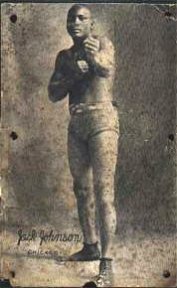
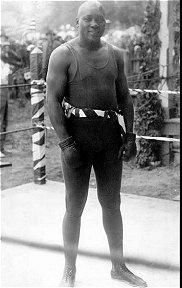
 In
his autobiography Johnson never complains, while he was wise enough to
gloss over the true story. After all he had tens of thousands of
dollars still coming from that Moran fight. Whether Irish elements drove
him out of England and France is not clear but we do know that the IRA
and Sinn Fein had agents quite capable of doing it. The lonely Jack Johnson
was driven into Spain. Interestingly he learned the skill of the Matador
from reigning Spanish experts -- even doing duty in the bullring.
In
his autobiography Johnson never complains, while he was wise enough to
gloss over the true story. After all he had tens of thousands of
dollars still coming from that Moran fight. Whether Irish elements drove
him out of England and France is not clear but we do know that the IRA
and Sinn Fein had agents quite capable of doing it. The lonely Jack Johnson
was driven into Spain. Interestingly he learned the skill of the Matador
from reigning Spanish experts -- even doing duty in the bullring.








 Fleeing
from the ubiquitous Chicago police who are hot on their trail they cross
over into Mexico at Juarez. At the time the Mexican Revolution was in full
swing. American Marines had taken Vera Cruz in 1915 when American business
interests were being expropriated as Carranza nationalized oil fields and
mines. It was at this time that Edward Doheny who would later be implicated
in the oil scandals of the Harding Administration lost his oil rights.
W.R. Hearst, the newspaper baron, lost his mining and ranching interests.
Burroughs and other Americans viewed these proceedings with horror. Thus
Barbara Harding and her father are about to lose their ranch, although
Pancho Villa was hardly the villain on that scene.
Fleeing
from the ubiquitous Chicago police who are hot on their trail they cross
over into Mexico at Juarez. At the time the Mexican Revolution was in full
swing. American Marines had taken Vera Cruz in 1915 when American business
interests were being expropriated as Carranza nationalized oil fields and
mines. It was at this time that Edward Doheny who would later be implicated
in the oil scandals of the Harding Administration lost his oil rights.
W.R. Hearst, the newspaper baron, lost his mining and ranching interests.
Burroughs and other Americans viewed these proceedings with horror. Thus
Barbara Harding and her father are about to lose their ranch, although
Pancho Villa was hardly the villain on that scene.
